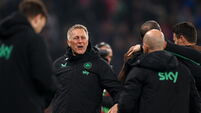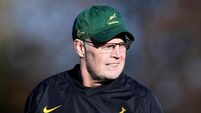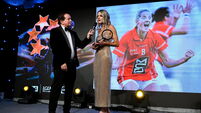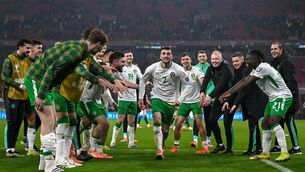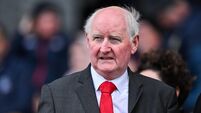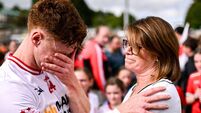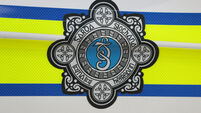Larry Ryan: Jim Sherwin a reminder of lost sporting versatility
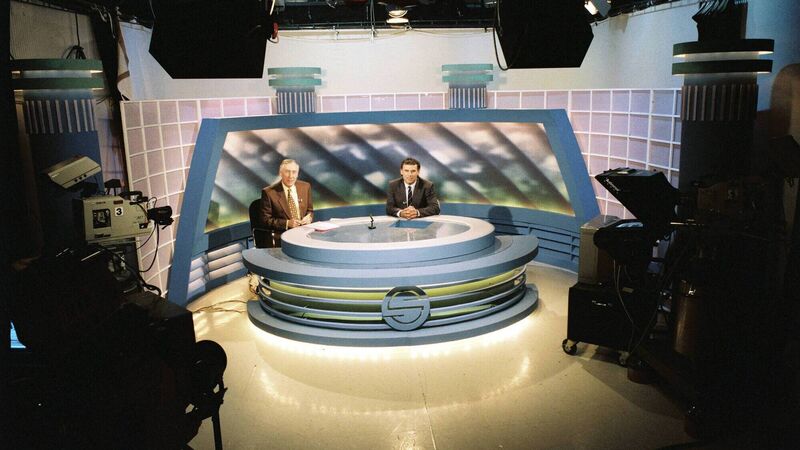
Jim Sherwin and Tony Ward on 'Sports Stadium' (1994)
It’s filling up, heaven’s homegrown dream team of faces and voices that gave many of us a sporting education.
There was a reminder of Mick Dunne’s contribution on this week’s production on RTÉ. One of the brainchildren behind the scheme, Mick would have to be rewarded up top on any selection, for those unforgettable ‘ooohhhh what a goalllll’ commentaries. Maybe in a front two with Michael O’Hehir.
Jimmy Magee would be in there of course, probably skipper, playing from memory. Billo pulling strings in the middle of the park, anchoring the side, leaving the odd foot in. Fred Cogley on the set pieces. It’s overrrrr! Brendan O’Reilly, elegant, unflappable, in constant communication with the gaffer in the dugout even if not always getting the right message. Philip Greene, keeping it tight, Rovers in front, one to nil.
There would be places for showjumping’s Brian McSharry, racing’s Noel Reid, Noel Andrews on the boxing, Brendan Delaney on the results. Colm Murray with the news. And Jerry Kiernan certainly, in the engine room, along later to deliver us a postgrad masters in athletics.
And now Jim Sherwin. Fair to call him the John O’Shea of the side? Doing a top-class job without fuss wherever selected.
Most weeks, you try to figure a reason for ringing legendary RTÉ Sport producer Michael O’Carroll again. Michael, now 85, remembers everyone and everything.
He recalls the day Jim approached him in Montrose with a nixer, since he was caught elsewhere himself. Handy number, would only take six or seven hours. You’d just need to scrub up and sanitise the camera. Because it would involve filming some kind of groundbreaking transplant surgery in the Blackrock Clinic while the surgeon commentated. Medical education videos were another of Sherwin’s specialties, when he wasn’t commentating on or presenting every sport around.
Not fond of blood, Michael made his excuses.
“That was Jim, though. He could turn his hand to anything. A good solid broadcaster who always had his research done. Olympics, rugby, tennis, he did athletics meetings with me. He did motor racing in Mondello, a couple of Grand Prix races. He even did a bit of navigation himself in a few rallies with Larry Mooney.
“And he was a lovely Irish speaker. Beautiful Irish. A fantastic all-rounder.”
Michael is well placed to assess versatility. He got back into journalism by jumping ship in Havana from his job as a pastry chef in the merchant navy to file copy by telex on the day Castro came to power.
In TV, he operated first when the producer was also the director, His self-effacing autobiography , released last year, is a joy of stories and recollections.
He was behind , . He directed the Muhammad Ali fight against Al Blue Lewis at Croke Park. Was Michael even responsible for Ali’s 11th round TKO?
“Because the fight started at least 10 minutes late, the satellite time was running out. I told my friend Harold Conrad who came into the outside broadcast truck. He immediately dashed to ringside. Within a minute or two the fight had ended. I am not saying that my words resulted in the stoppage but to me it seemed strange.”
It was Michael who knocked a hole in the front wall of squash courts so viewers could see the players’ faces. He introduced helicopter cameras to cycling.
When you’re complaining, these days, about golf coverage’s obsession with the leading groups, Michael hears ya. He reckons he was axed as RTÉ’s golf producer due to his insistence on looking down the field. “I tried to cover more than the top 10, with cameras being moved several times. The outside broadcast department complained about me bitterly to the sports bosses, for being too demanding.”
He recalls landing in Melbourne for a Grand Prix with no deal yet done with Bernie Eccelstone for Formula 1 rights — and having to introduce 800 years of oppression into the equation to indicate why the Irish should be given some kind of break. Bernie laughed and signed.
And Michael is great value on the GAA’s wariness of TV in the early days, as colour seeped into their black and white view. The fear was two-pronged. That nobody would go to a match again if it was on the box. And what if the cameras got too nosey?
Match director for 40 All-Ireland finals, he once “had to remove two in-goal cameras on All-Ireland day because the man in charge at Croke Park, God rest his soul, said he didn’t know about them and he was afraid of what they would show.
“Prior to 1965, the radio commentator was not allowed tell the listeners who was injured, who was sent off after a shemozzle, or what player drew a dirty stroke. When I joined the sports department, after much discussion, it was agreed to rid both Gaelic and hurling of the hatchet men.”
Only All-Ireland finals and Railway Cups could be screened those days though it was live coverage of the 1973 interpros that sharpened everyone’s focus.
“ABC Television paid £7,000 (€8,337) for the rights. We used that money to buy a 15/1 zoom lens for the outside broadcast department. It greatly enhanced our coverage from there on in.”
Gradually, the GAA recognised the promotion and revenue TV would bring and near the end of his career, Michael remembers Jim Sherwin confiding that he ought to have concentrated on Gaelic instead, such were the opportunities.
Jim often seemed to be confined to the Wales or France Five Nations action in the early evening, after Fred got the Ireland gig earlier. Though it’s easy to tell his first love from one of those Sports Stadium clips that turn up on the KillianM2 YouTube archive: “That’s the soccer out of the way. After the break, we’ll be concentrating on rugby.”
Nowadays, of course, the soccer is never out of the way. Or the GAA and rugby. And most of us are pretty happy with that state of affairs, that there is always a match on somewhere.
Once we were thankful for snippets of anything and over the years we decided what we wanted to see more of.
The current generation have it all, yet are they being denied that early all-round sporting education? When it all had more or less parity of esteem: The FA Cup, the Triple Crown, the Aga Khan, the Nissan Classic, the snooker from Goffs.
When men like Jim Sherwin and Michael O’Carroll could turn their hands to anything.


